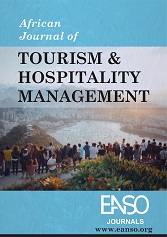Gastronomic Identity: A Review of the Environment, Culture and Economy Effect on Culinary Tourism
Abstract
Gastronomic identity encapsulates an individual's cultural background and food choices wherever they go to work or visit as tourists. The study evaluated various factors that are considered to influence gastronomic identity. The dominant environmental elements include geography and climate, which impact available agricultural products and the adaptability of new products due to trends, fashion, or demand from increased travel. The cultural elements included religions, history, ethnic diversity, innovations, capabilities, traditions, beliefs, and values. The tourism industry is not only affected by the environment but also by cultural and culinary heritage and the cost of living. Tourism is a way to promote traditions and customs. Eating habits are a matter of culture, a product of codes of conduct and the structure of social relationships. This study aimed to establish how Kenya’s vast cultures satiate their gastronomic identities while appreciating other cultures’ ethnic foods with the current economic situation. The study used a desktop review of studies in gastronomic identity. Findings will be used to provide information on gastronomic tourism. Understanding these concepts can be valuable when relating food choices, defining culinary tourism strategies, and local restaurant concepts
Downloads
References
Akombi, B., Agho, K., Merom, D., Renzaho, A., & Hall, J. (2017). Child malnutrition in sub-Saharan Africa: A meta-analysis of demographic and health surveys (2006-2016). PloS one, 12(5), e0177338.
Baldwin, W. (2018). Chef’s sabbatical: An analysis of chef’s gastronomic research through culinary tourism. International Journal of Gastronomy and Food Science, pp. 13, 65–72. https://doi.org/10.1016/j.ijgfs.2018.05.006
Byrd, K., Williams, A., Dentz, H. N., Kiprotich, M., Rao, G., Arnold, C. D., Null, A. C., Dewey, K. G., & Stewart, C. P. (2017). Differences in complementary feeding practices within the context of the wash benefits randomized, controlled trial of nutrition, water, sanitation, and hygiene interventions in rural Kenya. The FASEB Journal, 31(1 supplement), pp. 165–1.
Chen P. and Antonelli M. Conceptual Models of Food Choice: Influential Factors Related to Foods, Individual Differences, and Society 2020 MDPI
Choe, J. Y. J., & Kim, S. S. (2018). Effects of Tourists’ local food consumption value on attitude, food destination image, and behavioral intention. International Journal of Hospitality Management, 71, 1–10. https://doi.org/10.1016/j.ijhm.2017.11.007
de la Barre, S., & Brouder, P. (2013). Consuming stories: Placing food in the Arctic tourism experience. Journal of Heritage Tourism, 8, (2-3), 213-223
Dixit S. K. & Prayag G. (2022). Gastronomic tourism experiences and experiential marketing. Tourism Recreation Research, 47(3), 217- 220, DOI:10.1080/02508281.2022.2065089
Dixit, S. K. (2019). Gastronomic tourism: A theoretical construct. In S. K. Dixit (Ed.), The Routledge handbook of gastronomic tourism (pp. 13– 23). Routledge. https://doi.org/10.4324/9781315147628
Dixit, S. K. (2020). Marketing gastronomic tourism experiences. In S. K. Dixit (Ed.), The Routledge Handbook of Tourism Experience Management and Marketing (pp. 322–335). Routledge. https://doi.org/10.4324/9780429203916
Ellis, A., Park, E., Kim, S. & Ian Yeoman, I. (2018I). What is food tourism? Tourism Management, 68, 250– 263. https://doi.org/10.1016/j.tourman.2018.03.025.
GE du Rand, I. (2016). Culinary mapping and tourism development in South Africa's Karoo region. African Journal of Hospitality, Tourism and Leisure, 5(4), 1–22.
Global Nutrition Report (2018). What people eat and why it matters. https://media.globalnutritionreport.org/documents/Chapter_4_2018_Global_Nutrition_Report.pdf
Hall, C. M. (2020). Improving the recipe for culinary and food tourism? The need for a new menu. Tourism Recreation Research, 45(2), 284– 287. https://doi.org/10.1080/02508281.2019.1694243
Hall, C. M., & Prayag, G. (Eds.). (2019). The Routledge Handbook of halal hospitality and Islamic tourism. Routledge.
Hardcastle, S. J., Thøgersen-Ntoumani, C., Chatzisarantis, N. L. D. (2015). Food Choice and Nutrition: A Social Psychological Perspective. Nutrients, 7, 8712–8715. https://globalnutritionreport.org/reports/global-nutrition-report-2018/
Jebotip, J. (2021). A Critical Review of Gastronomic Tourism Development in Kenya, Journal of Hospitality and Tourism Management, Vol. 4(1), 27–39.
Kesimoglu, A. (2015). A reconceptualization of gastronomy as relational and reflexive. Hospitality & Society, 5(1), 71–91. https://doi.org/10.1386/hosp.5.1.71_1
Lopez H., T.E., Hernández C., Y., Sánchez C., L.M. and Pastaz V., M.M. (2019). Gastronomic Tourism: Attitudes, Motivations and Satisfaction of the Visitor in Cantons of Tungurahua, Ecuador. American Journal of Industrial and Business Management, 9, 699–719. https://doi.org/10.4236/ajibm.2019.93047
Ji, M., Wong, I., A., E., A. & Scarles, C. (2016). Food-related personality traits and the moderating role of novelty-seeking in food satisfaction and travel outcomes, Tourism Management, 57, 387- 396 https://doi.org/10.1016/j.tourman.2016.06.003
Mitchell, R. (2001). Taking advantage of the relationship between wine, food and tourism: joint marketing activities. In C. M. Kearsley, Tourism in New Zealand: an introduction. Oxford University Press.
Ondieki E. B., Kotut E. J. Gatobu C. K., Wambari E. M. (2017). Gastronomic Identity: Role of the Environment and Culture on Culinary Tourism. African Journal of Tourism, Hospitality and Leisure Studies, 3(1), 17-21, ISSN: 2413-4120 Copyright: 2017 AJTHLS Open Access – Online @ http://onlinesciencejournals.com/index.php/ajthls/index 1
Ramos, MP; Custodio, E; Jiménez, S; Mainar-Causapé, A; Boulanger, P; and Ferrari, E. Improving food security and nutrition indicators in Kenya through market incentives: a macro-microsimulation approach, EUR 30034 EN, Publications Office of the European Union, Luxembourg, 2020, ISBN 978-92-76-14654-4, doi:10.2760/925912, JRC119390.
Shepherd, R. (199). Social determinants of food choice. Proc. Nutr. Soc., 58, 807–812.
Steenkamp, J. -B. E. (1997). Dynamics in consumer behavior with respect to agricultural and food products. In Agricultural Marketing and Consumer Behavior in a Changing World; Kluwer Academic Publishers: Boston, MA, USA, pp. 143–188.
Swinburn, B. A., Sacks, G., Hall, K. D., McPherson, K., Finegood, D. T., Moodie, M. L., & Gortmaker, S. L. (2011). The global obesity pandemic: Shaped by international drivers and local environments. Lancet, 378, 804–814
World Tourism Organization (2021), International Tourism Highlights, 2020 Edition, UNWTO, Madrid, DOI: https://doi.org/10.18111/9789284422456.
Copyright (c) 2025 Eusabia Bosibori Ondieki

This work is licensed under a Creative Commons Attribution 4.0 International License.




























